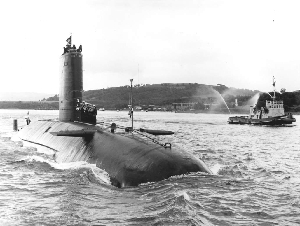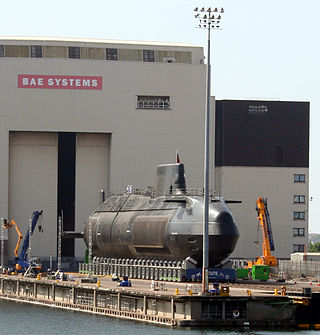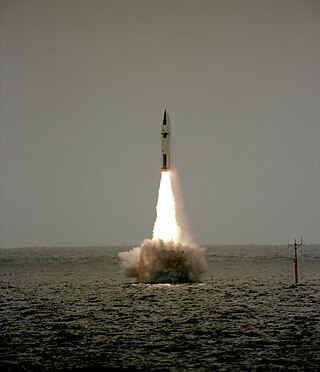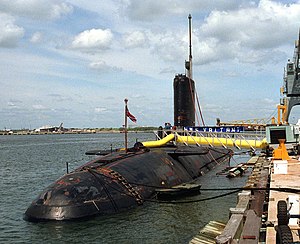
The Resolution class was a class of four nuclear ballistic missile submarines (SSBN) built for the Royal Navy as part of the UK Polaris programme. Each submarine was armed with up to 16 UGM-27 Polaris A-3 nuclear missiles.

HMS Astute (P447) was an Amphion-class submarine. Her keel was laid down by Vickers at Barrow-in-Furness. She was launched in 1944 and commissioned in 1945.

HMS Resolution (S22) was the first of the Royal Navy's Resolution-class ballistic missile submarines. She operated from 1968 until 1994 providing the UK Polaris at sea nuclear deterrent.

HMS Conqueror was a British Churchill-class nuclear-powered fleet submarine which served in the Royal Navy from 1971 to 1990. She was the third submarine of her class, following the earlier Churchill and Courageous, that were all designed to face the Soviet threat at sea. She was built by Cammell Laird at Birkenhead.

The seventh HMS Dreadnought was the United Kingdom's first nuclear-powered submarine, built by Vickers Armstrongs at Barrow-in-Furness. Launched by Queen Elizabeth II on Trafalgar Day 1960 and commissioned into service with the Royal Navy in April 1963, she continued in service until 1980. The submarine was powered by a S5W reactor, a design made available as a direct result of the 1958 US–UK Mutual Defence Agreement.

The Valiant class were a class of nuclear-powered fleet submarines in service with the Royal Navy from the mid-1960s until 1994. They were the first fully British nuclear fleet submarine; the earlier HMS Dreadnought used an American nuclear reactor. There were only two boats in the class, the first, Valiant commissioned in 1966 three years after Dreadnought, and Warspite the following year. Both were built by Vickers at Barrow-in-Furness.

HMS Onyx was an Oberon class submarine of the Royal Navy.
The Rolls-Royce pressurised water reactor (PWR) series has powered the Royal Navy's nuclear submarines since the Valiant class, commissioned in 1966.

A nuclear submarine is a submarine powered by a nuclear reactor, but not necessarily nuclear-armed. Nuclear submarines have considerable performance advantages over "conventional" submarines. Nuclear propulsion, being completely independent of air, frees the submarine from the need to surface frequently, as is necessary for conventional submarines. The large amount of power generated by a nuclear reactor allows nuclear submarines to operate at high speed for long periods, and the long interval between refuelings grants a range virtually unlimited, making the only limits on voyage times being imposed by such factors as the need to restock food or other consumables.

The latest HMS Warspite was the third of Britain's nuclear-powered submarines, and the second of the Valiant class. After entering service in 1967 she collided with a Soviet submarine the following year. A mechanical failure associated with the submarine's nuclear reactor in 1991 led to the boat being laid up at HMNB Devonport where she awaits disposal.

HMS Sealion (S07) was a Porpoise-class submarine.

The three Churchill class, sometimes known as the Repeat Valiant-class submarines were nuclear-powered fleet submarines which served with the Royal Navy from the 1970s until the early 1990s. The Churchill class was based on the older Valiant class, but featured many internal improvements.

HMS Renown (S26) was the third of the Royal Navy's Resolution-class ballistic missile submarines.

HMS Revenge (S27) was the fourth of the Royal Navy's Resolution-class ballistic missile submarines.

HMS Affray was a British Amphion-class submarine. It was the last Royal Navy submarine to be lost at sea, on 16 April 1951, with the loss of 75 lives.

HMS Courageous (S50) is a decommissioned Churchill-class nuclear fleet submarine in service with the Royal Navy from 1971. She is now a museum ship managed by the Devonport Naval Heritage Centre.
HMS Ambush (P418/S68/S18), was an Amphion-class submarine of the Royal Navy, built by Vickers Armstrong and launched 24 September 1945.

HMS Totem was a Group 3 T-class submarine of the Royal Navy which entered service in the last few months of World War II. To-date, she is the only ship of the Royal Navy to have been named Totem.

HMS Narwhal (S03) was a Porpoise-class submarine of the Royal Navy. She was launched on 25 October 1957.

The United Kingdom's Polaris programme, officially named the British Naval Ballistic Missile System, provided its first submarine-based nuclear weapons system. Polaris was in service from 1968 to 1996.



















